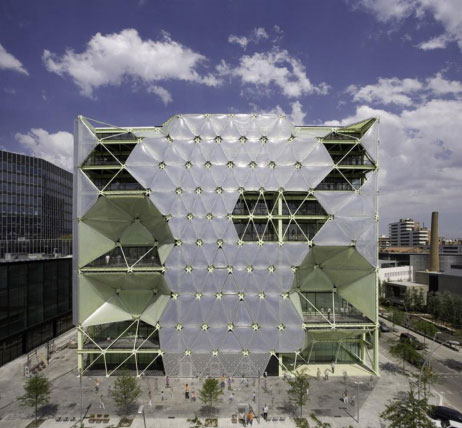Architecture Goes from Fortress to Porous
Gelitin materialized ‘oneness with nature’ by eroding the physical barriers when they created a decomposing sculpture. The group then dissolved mental barricades when they spoofed the hallowed practice of meditation. Andy Gracie, on the other hand, erased the divisions between artificial intelligence, botanical life, and an aquatic organism.
Eliminating entrenched borders is the overriding principle in each instance. The artists derived this principle from the manner in which natural systems evolve and maintain themselves.
Currently, architecture is another cultural phenomenon (added to biological sciences, religious practice, and robotics) that is dissolving borders! Complex architectural forms and functions are being achieved through advanced manufacturing of ‘smart’ materials and processes. These innovative designs generate active structures and responsive environments.
Enrique Ruiz-Geli of CLOUD 9 provides one compelling example.
His Media-ICT Building in Barcelona promises to fulfill a “cloud nine” expectation of extreme happiness. It relies on advanced “cloud computing” and “point cloud” technology for describing the external surface of an object. These “cloudy” technologies replace the modernist principle that architecture is an unchanging geometric solid surrounded by space.
Instead, the ICT Building mimics the structure, functioning, and dynamism of a biological organism.
As opposed to 20th c. Modernist architecture that was built of identical, mass produced units, the Media-ICT Building is formed out of many small units. These units correspond to cells by responding to the immaterial components of environment within their individual, micro habitats. They are sensitive to light, temperature, humidity, rain, wind, salt, CO2, etc. Furthermore, each is customized in the building’s design phase to reflect its unique structural and functional roles. Requirements diverge if the unit is located on the bottom where it must support loads, or the top. They differ if they are located where they receive the brunt of the sun or on a shady side. They deviate if they are in the path of winds or stillness.
The biological model applies to the structure.
– Like a body’s skeleton, the building is designed around a steel framework.
– Like a body’s tendons, cabling is calculated inch by inch to determine its specific load.
– Like the body’s joints, the brackets are individually designed to accommodate the cables/tendons.
– Like the body’s skin – the entire structure is covered with a membrane of ETFE material (layered) that is capable of moving over and around the skeleton.
The biological model applies to the functioning of these ‘organic’ parts:
– Like the nerve endings in the skin – the entire surface is outfitted with sensors that detect sun, heat, rain, wind. Unlike the adversarial relationship between building and landscape that is typical of a modernist ‘fortress’, the ICT building does not assume the exterior is inhospitable.
.
– Like the homeostatic system – each unit responds individually to its specific condition. Thus, areas that may be shaded by a neighboring building will remain ‘open’ while those receiving sunlight close to create shade.
– Like the body, responses are distributed throughout the building (organism), unlike a modernist building in which a centralized system makes these determinations.
– Like the pores in the skin, this buildings sweats. When outside layer heats, middle layer closes. Cushions inflate and it fills with a nitrogen-based fog that cools the building.
– Like any living organism, the ICT building is constantly adjusting to changing circumstances.
These resemblances are bolstered by the fact that the building is lit for approximately six hours each night without electricity. This biological feat is accomplished through the use of a bioluminescent system that mimics the jelly fish by absorbing daylight. Furthermore, the building grew into its mature form because each floor was assembled on the ground and then hoisted into place.
Ultimately, the building captures the ultimate condition of life because it designed to adapt to perpetually changing and unpredictable circumstances.